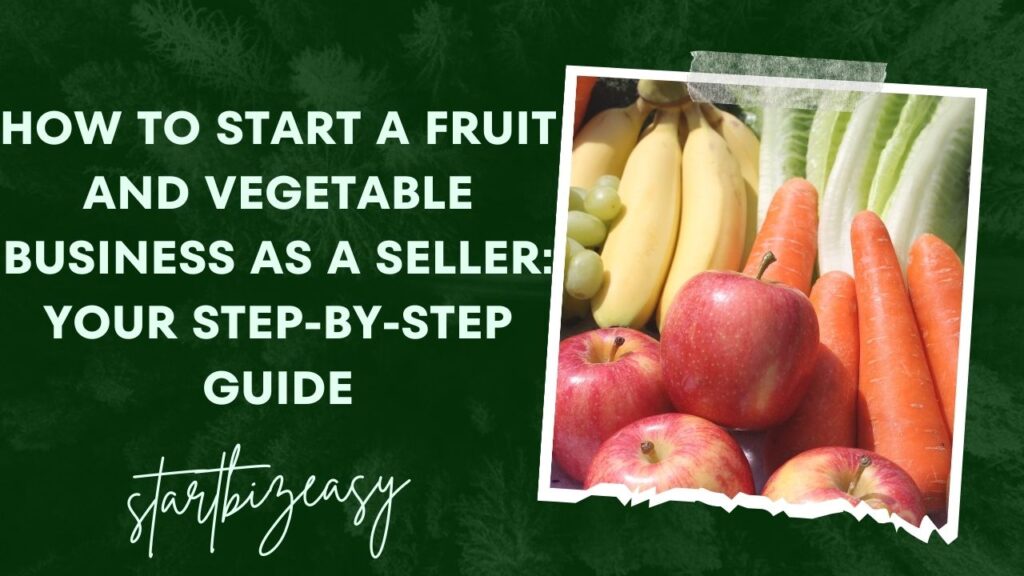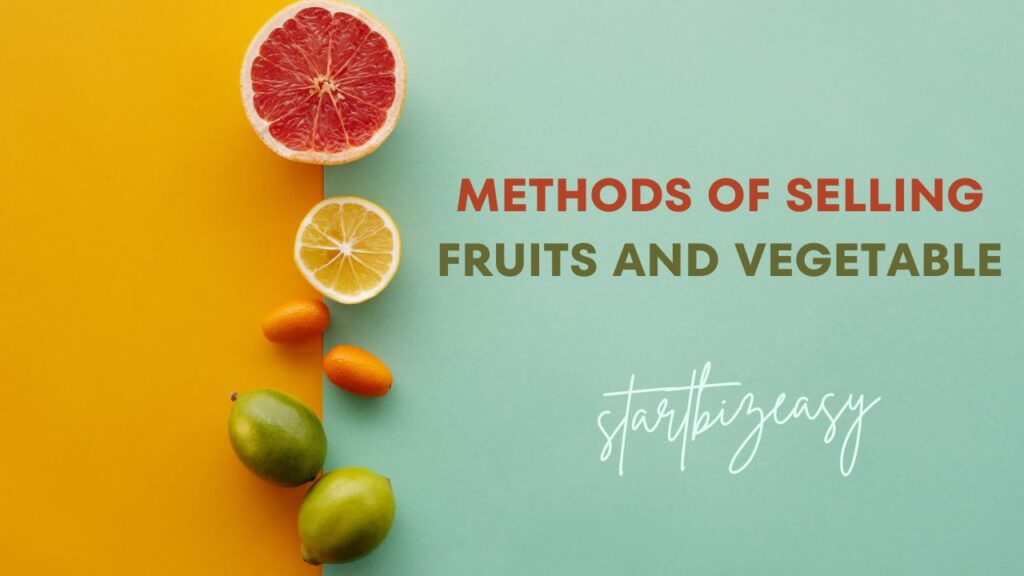
A fruit and vegetable business is a type of enterprise that involves the buying, selling, and distribution of fresh fruits and vegetables. These businesses can operate in various formats, including retail stores, farmers’ markets, wholesale distribution centers, online platforms, or as part of a larger agricultural operation.
In a fruit and vegetable business, the primary activities typically include sourcing produce from farms or suppliers, ensuring quality control and freshness, storing and handling inventory properly, and marketing and selling the products to consumers or other businesses.
Starting a fruit and vegetable business is not only a good business but a lucrative venture, provided it is well-planned, executed efficiently, and meets the demands of the market.
Here are the steps on how to start a fruit and vegetable business as a seller:
Table of Contents
1. Market Research and a Business Plan:
Before embarking on the journey of starting a fruit and vegetable business, it’s crucial to conduct thorough market research and develop a comprehensive business plan. This process lays the foundation for a successful venture by providing insights into the market landscape and guiding strategic decision-making. Here’s a breakdown of what each entails:
Market Research: Market research involves gathering and analyzing information about the demand for fruits and vegetables in your target area. This includes understanding the preferences, needs, and purchasing behavior of your potential customers. Conducting or researching on conducted surveys, interviews, or focus groups to gather data on consumer preferences, dietary habits, and shopping patterns related to fresh produce.
Additionally, assess the competitive landscape by identifying existing sellers of fruits and vegetables in your area. Understand their strengths, weaknesses, pricing strategies, and customer service practices. This analysis will help you identify gaps in the market and opportunities to differentiate your business from competitors.
Business Plan: With these insights, you can create a detailed business plan that acts as a roadmap for your business. This plan covers your goals, who you want to sell to, what you’re selling, how much you’ll charge, how you’ll advertise, and how much money you expect to make. It’s like a guidebook that helps you take the right steps and grow over time.
For example, what you learn about customers preferences from your market research will help you decide what to sell and how good it needs to be. And when you see what other sellers are charging, you can figure out how much you should charge too. Plus, knowing who your customers are helps you create ads that speak directly to them.
The financial part of your plan, based on your market research, shows if your business idea makes sense financially. By estimating how much it’ll cost to start your business, how much you’ll spend running it, and how much money you’ll bring in, you’ll know if your business can work and where you should spend your money.
By conducting market research and developing a detailed business plan, you’ll be better prepared to navigate the challenges and opportunities of starting a fruit and vegetable business. This strategic approach will increase your chances of success and help you build a thriving and sustainable business in the fresh produce industry.
2. Legal Considerations:
Navigating the legal landscape is like laying down a solid foundation for your fruit and vegetable business in Nigeria. Just as you wouldn’t build a house without sturdy support, you shouldn’t embark on your business journey without ensuring you’re on the right side of the law.
Firstly, you’ll need to register your business with the Corporate Affairs Commission (CAC). Think of this as securing your business’s identity card – it gives you a legal presence and distinguishes your business as a separate entity from yourself. This step involves choosing a business name, completing the necessary forms, and paying the required fees.
Next up, you’ll need to obtain permits and licenses specific to operating a food business. In Nigeria, this includes acquiring your Tax Identification Number (TIN) and adhering to health and safety regulations set by relevant agencies such as the National Agency for Food and Drug Administration and Control (NAFDAC) and the Standards Organisation of Nigeria (SON) -If you’re making fruits and vegetable products for people to eat or drink directly, like smoothies or fruit juice. These certifications ensure that your products meet quality standards and are safe for consumption.
Depending on the scale and nature of your business, you may also need to comply with additional regulations. For example, if you plan to operate a retail outlet, you may need a trade license from your local government authority. If you’re handling imported produce, you’ll need to navigate customs regulations and obtain necessary permits.
By taking care of these legal requirements upfront, you not only protect yourself and your business from potential legal issues but also build trust with customers. They’ll have confidence knowing that your business operates within the bounds of the law and prioritizes their safety and well-being.
3. Location and Setup:
When establishing your fruit and vegetable business in Nigeria, selecting the right location and ensuring an effective setup are crucial for success.
Selecting the right location is critical for the success of your fruit and vegetable business. Look for a strategic location with high foot traffic, good visibility, and easy accessibility. Ideal locations include busy street corners, shopping malls, farmers’ markets, or neighborhoods with high residential density.
Consider the demographics of the area, such as the population density, income levels, and consumer preferences. Choose a location that aligns with your target market and offers potential for attracting customers.
Accessibility is another important factor to consider. Ensure that your location is easily accessible by car, foot, or public transportation. Ample parking space or nearby public transit stops can encourage more customers to visit your business.
Once you’ve secured the location, focus on setting up your store or stall in a way that maximizes its appeal and functionality. A clean and organized environment is essential to attract customers and create a positive impression. Keep your space tidy and hygienic, regularly cleaning and sanitizing surfaces and storage areas.
Arrange your fruits and vegetables in an aesthetically pleasing manner, making it easy for customers to browse and select their items. Consider using display shelves, baskets, or bins to showcase your products attractively. Group similar items together and provide clear signage to aid navigation.
Beyond aesthetics, prioritize customer convenience. Ensure that your setup allows for smooth traffic flow and easy access to products. Provide shopping carts or baskets for customers to use, and consider offering seating areas or refreshments to enhance their shopping experience.
Lastly, use your store’s design and decor to reinforce your brand identity. Incorporate signage, logos, and branding materials that reflect your business values and differentiate you from competitors.
By carefully selecting your location and setting up your store or stall with these considerations in mind, you can create a welcoming and attractive space that attracts customers and sets the stage for a successful fruit and vegetable business in Nigeria.
4. Capital:
You can start your fruit and vegetable business with as little as N50,000 Naira on a small scale or as much as N5,000,000 Naira on a medium to large scale. The exact amount depends on how big you want your business to be and various factors like where you’ll operate, where you’ll get your fruits and veggies from, what kinds you’ll sell, and your business model.
To figure out the exact cost for your business, you’ll need a business plan. And to make a good business plan, you need market research. That’s why these tips you’re reading are here to help you get started. They’ll guide you through the process so you can come up with the right cost figures in your business plan.
This capital will be expent on various items such as:
- Rental Fees
- Equipment and Supplies (such as refrigeration units, display racks, weighing scales, packaging materials, and cleaning supplies).
- Inventory
- Licenses and Permits
- Marketing and Promotion(for medium to large scale of operation)
- Operating Expenses (such as utilities (electricity, water), employee wages (if applicable), transportation costs, and miscellaneous expenses).
- Contingency Fund
Once you have a clear picture of your capital needs, explore various financing options to secure the necessary funds. This may include:
- Personal Savings: Utilize your own savings to fund the startup costs of your business. This demonstrates your commitment and dedication to the venture and avoids accruing debt or giving up equity.
- Loans: Consider applying for small business loans from banks or financial institutions. Research different loan options and compare interest rates, terms, and repayment schedules to find the most favorable option for your business.
- Investment from Partners or Investors: Seek investment from family members, friends, or other potential partners or investors who believe in your business idea and are willing to provide financial support in exchange for equity or a share of profits. Present a compelling business plan and financial projections to attract potential investors.
- Grants and Government Programs: Explore grants, subsidies, or government programs available to small businesses in Nigeria. These initiatives may offer financial assistance, tax incentives, or other forms of support to help entrepreneurs start or grow their businesses.
- Crowdfunding: Consider crowdfunding platforms as a way to raise capital from a large number of individuals who contribute small amounts of money to support your business idea. Develop a compelling campaign that highlights the unique aspects of your fruit and vegetable business to attract backers.
Remember to evaluate the risks associated with each financing option and develop a risk management strategy to mitigate potential challenges. Be mindful of interest rates, repayment terms, and the impact of debt on your business’s cash flow and profitability. Ensure you have a contingency plan in place to address unforeseen expenses or fluctuations in revenue.
5. Sourcing Goods:
Sourcing goods for your fruit and vegetable business involves building strong relationships with suppliers to ensure a consistent and high-quality inventory. It begins with identifying reliable sources, such as local farmers, wholesale markets (easily found within the general market), or distributors within and outside your city, state (region) or country.
Once identified, it’s essential to evaluate the quality of their produce to ensure it meets your standards. Negotiating favorable terms, including pricing, delivery schedules, and payment terms, is crucial to securing the best deals for your business.
Maintaining open communication channels with suppliers is key to addressing any issues promptly and ensuring smooth operations. Building trust and rapport with your suppliers fosters a mutually beneficial partnership.
Additionally, diversifying your sources of supply can help mitigate the risk of disruptions and provide options for sourcing specialty or seasonal produce.
6. Inventory Management:
Inventory management is the backbone of a successful fruit and vegetable business. This crucial aspect of operations involves several key practices aimed at minimizing waste and ensuring the optimal freshness of produce.
Efficient inventory management starts with accurate forecasting of demand. By understanding customer preferences and seasonal fluctuations, businesses can order appropriate quantities of fruits and vegetables to meet demand without overstocking. Overstocking leads to wastage as perishable items may spoil before they can be sold.
To maintain optimal freshness, businesses must monitor inventory levels closely. Regular inventory checks help ensure that stock levels are sufficient without being excessive. This prevents the accumulation of excess inventory that could lead to spoilage or waste.
Monitoring expiration dates is essential for preventing the sale of expired or spoiled produce. Businesses must implement procedures to remove expired items from shelves promptly. This not only maintains food safety standards but also preserves customer trust in the quality of the products.
Implementing a stock rotation system is another critical aspect of inventory management. By prioritizing the sale of older stock before newer items, businesses can minimize the risk of spoilage and ensure that customers receive the freshest produce possible.
Investing in proper storage facilities and refrigeration equipment is paramount for preserving the quality of perishable items. Cold rooms, refrigeration units, and humidity-controlled storage areas help maintain the optimal temperature and humidity levels for different types of produce. Regular maintenance and calibration of refrigeration equipment are necessary to prevent breakdowns that could lead to spoilage.
Overall, effective inventory management practices help fruit and vegetable businesses minimize waste, ensure product freshness, maximize profitability, and meet customers demand.
7. Pricing and Packaging:
When it comes to pricing and packaging in your fruit and vegetable business, striking the right balance is crucial. Pricing your products competitively is essential to attract customers and remain viable in the market. However, it’s equally important to ensure that your prices allow for profitability and sustainability.
When setting prices for your fruits and vegetables, consider various factors such as product quality, freshness, and market demand. High-quality produce that is fresh and in-season can command higher prices, especially if there is strong demand for it. On the other hand, you may need to adjust prices for items that are less popular or nearing their expiration dates to encourage sales and prevent waste.
It’s also essential to stay competitive by researching the prices charged by other sellers in your area. While you want to set prices that allow for profitability, pricing your products too high may drive customers away. Conversely, pricing them too low could compromise your margins and undermine the perceived value of your offerings.
Investing in attractive and functional packaging also have a significant impact on your business. Packaging serves multiple purposes, including protecting your products from damage during transportation and storage, extending their shelf life, and enhancing their visual appeal to customers. Well-designed packaging help differentiate your products from competitors and create a positive impression on consumers.
Additionally, opt for packaging that allows for proper ventilation to prevent moisture buildup. Offering different packaging options can cater to the diverse needs of your customers. For example, you might offer bulk packaging for wholesale customers and smaller, pre-packaged portions for retail consumers. Providing customizable packaging solutions allows customers to choose the option that best suits their needs and preferences, enhancing their overall shopping experience.
Consider using eco-friendly packaging materials whenever possible to appeal to environmentally-conscious consumers and reduce your environmental footprint. Clear and informative labeling can also help customers make informed purchasing decisions and build trust in your brand.
By carefully considering pricing and packaging strategies in your fruit and vegetable business, you can optimize profitability while providing value and satisfaction to your customers.
8. Quality and Customer Service:
Quality and customer service are the cornerstones of a successful fruit and vegetable business. Customers expect fresh, flavorful produce and excellent service when they choose to buy from you, so it’s essential to prioritize these aspects of your business to build trust and loyalty among your customer base.
First and foremost, focus on offering high-quality fruits and vegetables that meet or exceed your customers’ expectations. Source your produce from reputable suppliers who provide fresh, locally-sourced products whenever possible. Regularly inspect your inventory to ensure that it meets your quality standards, and promptly remove any items that are past their prime or otherwise unsuitable for sale. By consistently delivering top-quality produce, you’ll establish your business as a trusted source for fresh, flavorful fruits and vegetables in your community.
In addition to product quality, providing excellent customer service is crucial for building positive relationships with your customers. Train your staff to be knowledgeable about the fruits and vegetables you offer, including their varieties, flavor profiles, and uses. Encourage them to engage with customers, answer questions, and offer recommendations based on their preferences and needs. A friendly, helpful demeanor goes a long way toward creating a positive shopping experience and fostering customer loyalty.
Listen to your customers’ feedback and take it seriously. Whether it’s praise, criticism, or suggestions for improvement, every customer’s opinion matters. Actively solicit feedback through surveys, comment cards, or online reviews, and use this information to identify areas where you can enhance your offerings or service. By demonstrating that you value your customers’ input and are committed to continuously improving their experience, you’ll build trust and loyalty over time.
Finally, go above and beyond to exceed your customers’ expectations whenever possible. Offer personalized service, such as helping customers select the perfect produce for their needs or providing cooking tips and recipe ideas. Consider implementing loyalty programs or special promotions to reward repeat customers and encourage them to keep coming back. By demonstrating your commitment to quality and customer satisfaction in every interaction, you’ll earn the trust and loyalty of your customers and position your fruit and vegetable business for long-term success.
9. Marketing and Promotion:
Marketing and promotion play a pivotal role in the success of your fruit and vegetable business. It’s not just about having quality products; it’s also about making sure your target customers know about them and choose them over alternatives. To effectively market and promote your business, you need a comprehensive strategy that leverages both online and offline channels.
Online presence is critical in today’s digital age. Start by creating a professional website (optional) that showcases your products, services, and brand story. Utilize social media platforms like Facebook, Instagram, and Twitter to engage with your audience, share updates, and showcase your offerings through appealing visuals and informative content. Consider running targeted ads on these platforms to reach potential customers in your local area or specific demographic groups.
In addition to digital marketing, don’t overlook traditional offline channels. Local advertising in newspapers, magazines, or community newsletters can help raise awareness of your business among residents in your area. Distributing flyers or postcards in nearby neighborhoods or high-traffic areas can also attract the attention of potential customers. Participating in community events, farmers’ markets, or food festivals provides an excellent opportunity to interact with customers face-to-face, showcase your products, and build relationships within the community.
Take advantage of branding as part of your marketing strategy. Building a strong brand identity is essential for standing out in a crowded market. Define what sets your business apart from competitors—whether it’s your commitment to quality, your emphasis on locally-sourced produce, or your exceptional customer service—and communicate this message consistently across all marketing channels. Use your brand story to connect with customers on an emotional level and build loyalty over time.
Customer reviews and testimonials can also be powerful marketing tools. Encourage satisfied customers to leave positive reviews on your website, social media pages, or review platforms like Google My Business or Yelp. Word-of-mouth recommendations from happy customers can significantly influence others’ purchasing decisions and help you attract new business.
Ultimately, a successful marketing and promotion strategy requires a combination of creativity, consistency, and customer-centricity. By leveraging a mix of online and offline channels, building a strong brand identity, and prioritizing customer satisfaction, you can effectively market your fruit and vegetable business and attract a loyal customer base.
Methods of Selling Fruits and Vegetable

Selling fruits and vegetables can be done through various methods, depending on factors such as target market, location, and business model. Here are some common methods of selling fruits and vegetables:
- Retail Stores: Operating a retail store, such as a grocery store, supermarket, or specialty produce shop, is a traditional method of selling fruits and vegetables. Retail stores offer a wide range of products and cater to a diverse customer base.
- Farmers’ Markets: Farmers’ markets provide a platform for local farmers and growers to sell their produce directly to consumers. These markets are usually held on weekends or specific days of the week and attract shoppers looking for fresh, locally-sourced products.
- Roadside Stands: Setting up a roadside stand or a pop-up market is a cost-effective way to sell fruits and vegetables, especially for small-scale growers. These stands are typically located along busy roadsides or in rural areas and offer convenience to passing motorists and pedestrians.
- Community Supported Agriculture (CSA): CSA programs allow consumers to purchase a share of a farm’s harvest in advance and receive regular deliveries of fresh produce throughout the growing season. Farmers benefit from guaranteed sales and direct relationships with customers, while consumers enjoy access to seasonal, locally-grown produce.
- Online Marketplaces: Selling fruits and vegetables through online marketplaces and e-commerce platforms has become increasingly popular, especially with the rise of digital shopping. Farmers and retailers can set up virtual storefronts and reach a wider audience of customers who prefer the convenience of online shopping.
- Wholesale Distribution: Selling fruits and vegetables in bulk to restaurants, hotels, schools, and other institutions is another option for growers and wholesalers. Wholesale distribution requires efficient logistics and transportation networks to deliver fresh produce to commercial buyers on time.
- Mobile Markets: Mobile markets, such as food trucks or mobile farmers’ markets, bring fresh produce directly to communities that lack access to traditional grocery stores. These mobile units can visit various neighborhoods on scheduled routes and provide convenient shopping options for residents.
- Pick-Your-Own (PYO): PYO farms allow customers to visit the farm and pick their own fruits and vegetables directly from the fields. This hands-on experience is popular among families and individuals looking for a fun and interactive way to source fresh produce.
- Subscription Services: Offering subscription-based services, such as fruit and vegetable box deliveries, allows customers to receive a curated selection of seasonal produce on a regular basis. Subscription services provide convenience and consistency to customers while ensuring steady sales for growers and sellers.
- Cooperatives: Joining or establishing a cooperative with other farmers or growers can provide collective marketing and distribution opportunities. Cooperatives pool resources, share costs, and leverage economies of scale to market and sell fruits and vegetables more effectively.
Each method of selling fruits and vegetables has its advantages and challenges, so it’s essential to choose the approach that best aligns with your business goals, target market, and resources available. Additionally, combining multiple selling methods can help diversify revenue streams and reach different customer segments effectively.
Fruits that are most Profitable
The profitability of fruits can vary depending on factors such as market demand, production costs, seasonality, and geographic location. However, some fruits are generally considered to be more profitable due to their popularity, high demand, and potential for higher prices. Here are a few examples:
- Berries: Berries such as strawberries, blueberries, raspberries, and blackberries are often highly profitable due to their popularity and versatility. They are in high demand for fresh consumption, as well as for use in various food products such as jams, juices, and desserts.
- Avocado: Avocado has experienced a surge in popularity in recent years due to its nutritional benefits and culinary versatility. Avocado trees can be highly productive, and the fruit commands premium prices in many markets, making it a profitable crop for growers.
- Citrus Fruits: Citrus fruits such as oranges, lemons, and limes are perennial favorites with consumers due to their refreshing flavor and high vitamin C content. Citrus orchards can yield high volumes of fruit, and well-managed citrus farms can be highly profitable.
- Grapes: Grapes are not only consumed fresh but are also used to make wine, juice, and dried fruits such as raisins. Wine grapes, in particular, can be very profitable, especially if the grapes are used to produce high-quality wines that command premium prices.
- Tropical Fruits: Tropical fruits like mangoes, pineapples, and papayas are prized for their exotic flavors and nutritional benefits. While tropical fruits may require specific growing conditions, they can be highly profitable in markets where they are in high demand.
- Apples: Apples are one of the most widely consumed fruits globally and can be profitable for growers, especially if they cultivate premium varieties with excellent taste, texture, and appearance.
- Bananas: Bananas are a staple fruit in many parts of the world and are consumed fresh or used in various culinary applications. Bananas are generally profitable due to their high yields and consistent demand throughout the year.
While these fruits offer higher profitability in general, it’s essential to consider factors such as sourcing costs, market demand, competition, and potential risks when selecting which fruits to sell. Conducting thorough market research and assessing the local market dynamics can help determine the most profitable fruits to cultivate or sell in a specific area.
Vegetables that are most Profitable
Some vegetables are generally considered to be more profitable due to their popularity, high demand, and potential for higher prices. Here are a few examples:
- Leafy Greens: Leafy greens such as spinach, kale, lettuce, and Swiss chard are popular choices for health-conscious consumers and are often in high demand. They can be profitable crops for growers, especially if they are grown organically or sold as specialty varieties.
- Tomatoes: Tomatoes are one of the most widely consumed vegetables worldwide and can be profitable for growers, particularly if they cultivate premium heirloom or vine-ripened varieties. Tomatoes are versatile ingredients used in salads, sauces, soups, and sandwiches, making them a staple in many kitchens.
- Bell Peppers: Bell peppers come in various colors and are prized for their sweet flavor and crisp texture. They can be profitable for growers, especially if they produce high-quality, blemish-free peppers that command premium prices in the market.
- Cucumbers: Cucumbers are popular vegetables used in salads, sandwiches, pickles, and other culinary applications. They can be profitable for growers, particularly if they cultivate high-yielding varieties and implement efficient growing practices.
- Carrots: Carrots are nutritious root vegetables that are widely consumed fresh or cooked. They can be profitable for growers, especially if they cultivate sweet and crunchy varieties that appeal to consumers.
- Microgreens: Microgreens are young vegetable greens harvested at an early stage of growth. They are prized for their intense flavor, vibrant colors, and nutritional benefits. Microgreens can be highly profitable for growers, especially if they target niche markets such as upscale restaurants, farmers’ markets, and specialty grocery stores.
- Radishes: Radishes are fast-growing root vegetables that are popular for their peppery flavor and crunchy texture. They can be profitable for growers, especially if they cultivate specialty varieties such as watermelon radishes or French breakfast radishes.
- Herbs: Culinary herbs such as basil, parsley, cilantro, and mint are essential ingredients in many dishes and can be profitable for growers, especially if they sell fresh, high-quality herbs to restaurants, caterers, and consumers.
- Garlic: Garlic is a flavorful bulb used in a wide range of cuisines worldwide. It can be profitable for growers, especially if they cultivate premium varieties and sell them directly to consumers or through farmers’ markets.
- Zucchini and Squash: Zucchini and squash are prolific summer vegetables that are versatile and easy to grow. They can be profitable for growers, especially if they produce high yields and market them during the peak growing season.
Ultimately, the profitability of selling vegetables depends on factors such as quality, freshness, market demand, and pricing strategy. Conducting thorough market research, identifying niche opportunities, and producing high-quality produce can help growers maximize their profitability in the vegetable market.
Recommended Articles:
- How to Start Fruit and Vegetable Farming Business: Your Complete Step-By-Step Guide
- How to Start Fruit Juice Business in Nigeria: The Insider’s Step-By-Step Guide
- Rice Business in Nigeria Made Easy: A Success Guide
- Key Steps to Becoming a Successful Palm Oil Supplier in Nigeria
- How to Run a Profitable Snail Farming Business in Nigeria: Step-By-Step Guide
- Step-By-Step Guide to Starting a Profitable Poultry Farming Business in Nigeria
- How to Start a Profitable Catfish Farming Business in Nigeria: Step-by-Step Guide
- Top 11 Money Making Agriculture Business Ideas
- How to Start a Crocodile and Alligator Farm: The Ultimate Guide to Starting Your Own Wildlife Adventure
Discover more from StartBizEasy
Subscribe to get the latest posts to your email.





